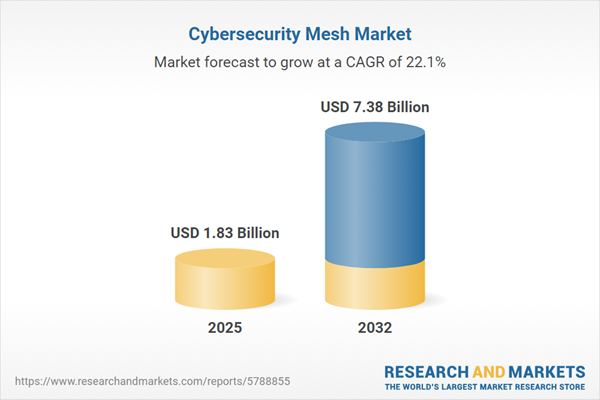Speak directly to the analyst to clarify any post sales queries you may have.
The cybersecurity mesh market is now pivotal for organizations seeking scalable, adaptive frameworks to mitigate rising digital risks. For senior leaders, these mesh solutions represent an opportunity to enhance operational resilience and maintain compliance as digital environments evolve.
Market Snapshot: Cybersecurity Mesh Market Growth and Outlook
In 2024, the cybersecurity mesh market stood at USD 1.49 billion, with enterprise spending indicating a surge in adaptive security adoption. Expected growth brings this market to USD 1.83 billion in 2025 and eventually to USD 7.38 billion by 2032, reflecting a compound annual growth rate (CAGR) of 22.08%. Enterprise priorities around identity-centric frameworks, adaptive architectures, and business continuity are fueling this rapid expansion. Standardized mesh solutions now form the backbone of regulated market operations, helping organizations sustain high availability under increasing regulatory scrutiny and technological change. The trend toward composable mesh frameworks is supported by expanding cloud, hybrid, and distributed operational models that demand seamless integration and real-time compliance.
Scope & Segmentation: Trends in the Cybersecurity Mesh Market
This report delivers actionable guidance for optimizing cybersecurity mesh frameworks within complex enterprise landscapes. Key segments, regional outlooks, and core technologies are examined to inform procurement and strategy decisions.
- Component: Access control solutions refine permission policies and increase authorization precision. Data security platforms employ advanced encryption to safeguard privacy. Endpoint security mitigates user device threats. Identity governance delivers strong authentication oversight. Network security applies segmentation and next-generation firewalls across distributed assets.
- Deployment Mode: Cloud-based frameworks enable rapid deployment and regular security updates, reducing manual effort. Hybrid models support organizations with multifaceted compliance needs. On-premises options offer control for entities with stringent data sensitivity or regulatory mandates.
- Organization Size: Large enterprises benefit from unified mesh deployments, automating controls across multiple business lines. Small and mid-market organizations leverage modular mesh approaches, matching scalable security to limited IT resources.
- End User Industry: Financial services deploy mesh for enhanced compliance. Energy, manufacturing, and utilities invest in operational resilience. Public sector agencies enforce advanced protections for sensitive data. Healthcare aligns mesh with privacy requirements. IT, telecom, and retail emphasize reliability and customer trust via data integrity.
- Region: The Americas drive cloud-enabled mesh adoption and lead infrastructure integration. EMEA focuses on privacy legislation and nuanced public sector demands. Asia-Pacific regions show agility in modernizing and respond to evolving compliance standards.
- Leading Companies: Microsoft, Fortinet, Palo Alto Networks, Cisco Systems, Splunk, CrowdStrike, IBM, Check Point, Zscaler, and Okta deliver customizable cybersecurity mesh platforms adopted globally.
Key Takeaways: Critical Insights for Cybersecurity Mesh Adoption
- Adaptive policy management empowers rapid updates to security postures, scaling with new threats and business changes.
- The ongoing growth in remote and hybrid work underscores the need for continuous endpoint monitoring across all users and environments.
- API-first and composable approaches streamline mesh integration, preparing organizations for emerging compliance demands and future technologies.
- Industry-specific drivers are shaping adoption strategies: financial organizations elevate oversight, healthcare and public sectors prioritize layered data privacy, while energy and critical infrastructure focus on continuity.
- Regional dynamics continue to shape strategic choices, with North America emphasizing robust infrastructure, EMEA upholding stringent privacy standards, and Asia-Pacific rapidly advancing modernization initiatives.
- Collaboration is strengthened through behavioral analytics and federated identity management, supporting secure, multi-entity ecosystem management.
Tariff Impact: United States Tariffs Reshaping Mesh Supply Chains
Amid recent shifts in United States tariffs, enterprises are transforming procurement and investment approaches. This transition accelerates reliance on cloud-based solutions and broader partnerships, helping organizations address region-specific compliance demands and adapt to global trade uncertainties while sustaining resilient security operations.
Methodology & Data Sources
This market analysis is built on a mix of open-source intelligence, proprietary data from leading vendors, updates on regulatory developments, and interviews with industry experts. Comprehensive intelligence and verified enterprise financials reinforce the findings presented here.
Why This Report Matters: Actionable Insights for Senior Leaders
- Enables proactive preparation for regulatory evolution and strategic investment in adaptive cybersecurity mesh solutions.
- Supports decision-makers in aligning resilience and compliance objectives while simplifying technology and partner selection.
- Delivers a holistic perspective for managing digital risk and securing ongoing business agility through informed, adaptable strategies.
Conclusion
This cybersecurity mesh report equips leaders to build flexible, resilient strategies for digital risk management. Executives can anticipate regulatory and operational shifts, strengthening security investments and organizational confidence.
Additional Product Information:
- Purchase of this report includes 1 year online access with quarterly updates.
- This report can be updated on request. Please contact our Customer Experience team using the Ask a Question widget on our website.
Table of Contents
3. Executive Summary
4. Market Overview
7. Cumulative Impact of Artificial Intelligence 2025
Companies Mentioned
The companies profiled in this Cybersecurity Mesh market report include:- Microsoft Corporation
- Palo Alto Networks, Inc.
- Fortinet, Inc.
- Cisco Systems, Inc.
- Splunk Inc.
- CrowdStrike Holdings, Inc.
- International Business Machines Corporation
- Check Point Software Technologies Ltd.
- Zscaler, Inc.
- Okta, Inc.
Table Information
| Report Attribute | Details |
|---|---|
| No. of Pages | 181 |
| Published | October 2025 |
| Forecast Period | 2025 - 2032 |
| Estimated Market Value ( USD | $ 1.83 Billion |
| Forecasted Market Value ( USD | $ 7.38 Billion |
| Compound Annual Growth Rate | 22.0% |
| Regions Covered | Global |
| No. of Companies Mentioned | 11 |









